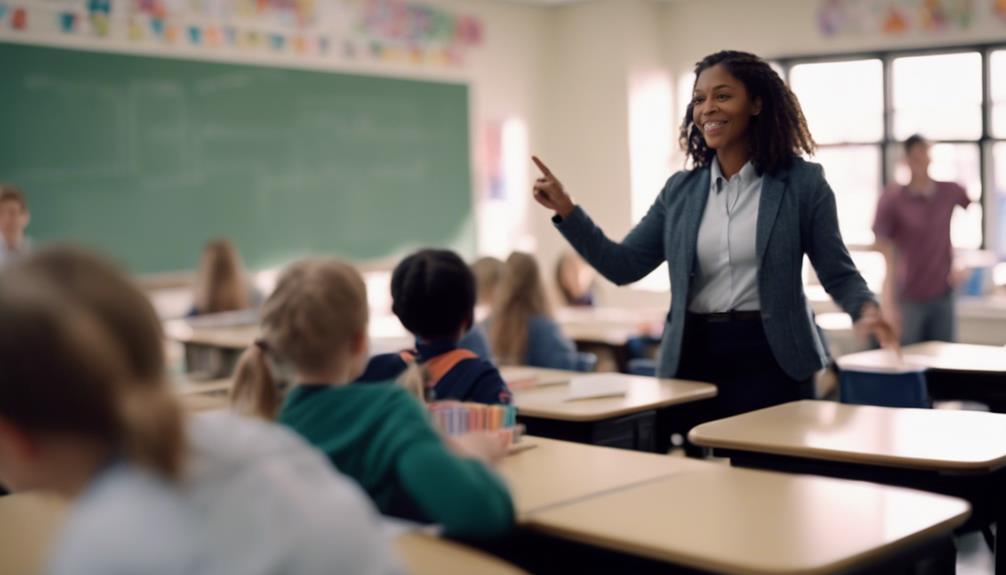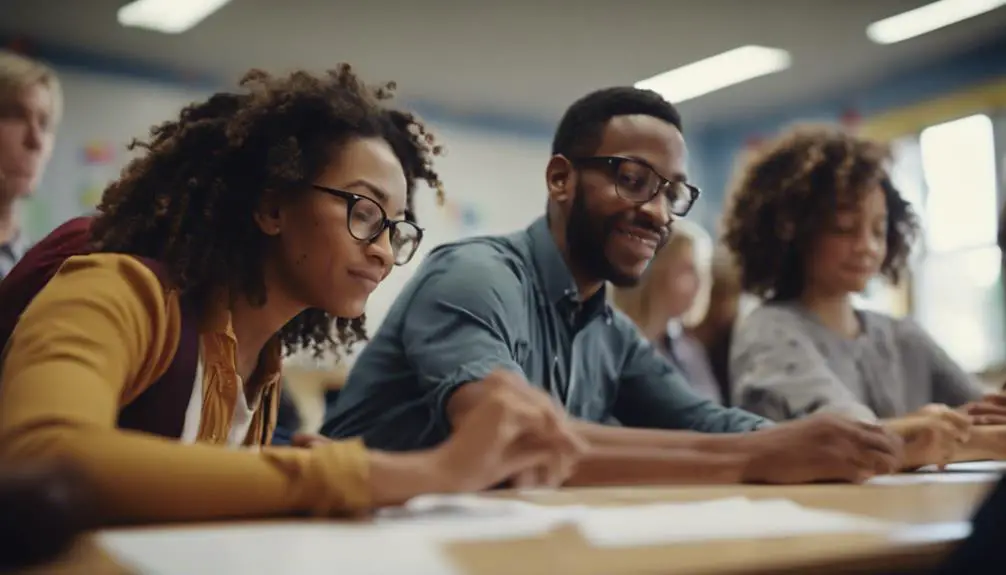Teacher movement in the classroom plays a crucial role in enhancing student learning and engagement. By purposefully navigating the teaching space, educators can promote active participation and forge stronger connections with their students.
This simple practice can significantly transform the educational experience for both teachers and learners. The impact of teacher movement is profound, contributing to a dynamic and interactive classroom environment. It allows educators to interact with students more effectively, adapt teaching methods based on student responses, and create a sense of inclusivity and connection.
Overall, the intentional movement of teachers in the classroom is a powerful tool that can positively influence the learning outcomes and overall classroom atmosphere.
15 importance of teacher movement in the classroom

Moving around the classroom has proven to be highly beneficial in teaching. It actively engages students, strengthens the bond between teachers and students, and contributes to a positive classroom atmosphere.
Additionally, it aids in effective classroom management, encourages student involvement, and showcases the teacher’s passion and vitality for the subject matter.
Active Engagement With Students
When I move around the classroom while teaching, it allows me to interact better with students, encouraging active engagement and improving learning outcomes. Active engagement through movement strategies creates a dynamic learning environment that boosts student participation and understanding.
Being present in different areas of the classroom during lessons enables me to engage with students individually, address their questions promptly, and provide immediate feedback, all vital aspects of interactive teaching.
By actively moving around, I ensure that students are fully involved in the learning process, leading to enhanced comprehension and retention of the material.
Active Engagement Benefits:
- Enhances student participation
- Fosters better understanding
- Encourages peer-to-peer interaction
- Improves student-teacher rapport
Enhances Teacher-Student Connection
Enhancing the connection between teachers and students in the classroom is made easier by strategic movement throughout the learning space. Active movement fosters a sense of teacher presence that positively impacts student interaction and engagement. Here are three ways in which teacher movement enhances the teacher-student connection:
- Increased Classroom Connection: Moving around allows teachers to connect with students on a more personal level, creating a supportive and welcoming environment.
- Enhanced Student Interaction: By being physically present in different areas of the classroom, teachers encourage students to engage more actively with the lesson and with them.
- Improved Learning Environment: A dynamic teaching approach through movement helps create a vibrant and stimulating learning environment that promotes student participation and collaboration.
Supports Classroom Management
Strategic teacher movement in the classroom is key to effective classroom management. By actively moving around the classroom, teachers can monitor student engagement, address disruptions promptly, and provide individual support when needed. This physical presence helps establish authority and creates a positive learning environment.
Techniques like circulating during group work, using proximity control to redirect off-task behavior, and consistently scanning the room can help manage classroom dynamics effectively. Taking a proactive approach to behavior management not only promotes order but also fosters a respectful and productive atmosphere where students can excel academically and socially.
Encourages Student Participation
As I move around the classroom, students become more engaged and active in the learning process. Here are three ways my teacher movement encourages student participation:
- Visual Cues: Moving around allows me to make eye contact, gesture, and interact with students, providing visual cues that help keep them engaged and attentive.
- Active Participation: By circulating, I create a dynamic environment where students feel motivated to actively participate in discussions, group activities, and class exercises.
- Enhanced Classroom Dynamics: My movement energizes the atmosphere, fostering a positive learning environment where students feel comfortable sharing their thoughts and engaging with the lesson.
Demonstrates Enthusiasm and Energy
Utilizing movement in the classroom not only keeps students engaged but also showcases my passion and energy for teaching. By incorporating active teaching techniques, such as moving around during discussions and using gestures to highlight key points, I can create a lively learning environment that encourages student participation.
This dynamic approach enhances classroom dynamics, fosters an energetic atmosphere, and promotes active engagement in the learning process. Through interactive activities and positive teacher-student interaction, students are more likely to stay focused, retain information better, and actively participate in lessons.
My energetic presence not only captures students’ attention but also conveys my enthusiasm for the subject, motivating them to engage and learn actively.
Facilitates Visual Learning Cues
When I teach, incorporating strategic movements is key to visually signaling students, helping them grasp and remember essential concepts better. Moving around not only keeps students active but also aids in their understanding. Here’s how I use movement to enhance learning through visual cues:
- Improved Memory Recall: Connecting movements to specific ideas helps students remember information more effectively.
- Enhanced Engagement: Visual cues grab students’ focus, strengthening their connection to the lesson.
- Active Participation: Movement encourages students to actively engage in the class, fostering a lively learning environment that supports participation.
Promotes Student Focus
Incorporating intentional movements during teaching sessions is crucial for capturing and maintaining students’ attention, which helps promote their focus in the classroom. When teachers move around the classroom, it increases student engagement by providing visual stimulation and creating a dynamic learning environment.
This active participation encourages students to stay focused on the lesson, fostering a classroom atmosphere conducive to learning. By strategically incorporating teacher movement, educators can guide students’ attention to key points, ensuring that classroom focus is maintained throughout the session.
This approach not only enhances student engagement but also promotes active participation, making the learning experience more interactive and stimulating for everyone involved.
Shows Teacher Accessibility
Teacher mobility within the classroom not only helps students stay engaged but also shows that the teacher is easily approachable, creating a friendly and interactive learning environment. When I move around during lessons, it lets students know that I’m available to help and support them, making the classroom atmosphere more inclusive.
Being active in the classroom allows me to interact with students one-on-one, catering to their individual needs and encouraging collaboration among them. This hands-on approach not only strengthens the bond between teacher and student but also fosters a cooperative and encouraging space for learning to flourish.
Provides Immediate Feedback
The movement of a teacher in the classroom directly impacts the immediacy of feedback provided to students by enabling real-time interaction. When a teacher actively moves around, they can adjust their teaching based on students’ responses on the spot.
Using gestures and visual cues, teachers can engage students dynamically, leading to enhanced focus and better understanding. This active presence not only shows teacher accessibility but also helps to build a stronger connection with students.
When teachers move around the classroom, they can quickly assess comprehension levels, address misconceptions immediately, and offer timely support. This instant feedback loop creates a responsive learning environment where students feel supported and motivated to actively participate in their learning journey.
Enhances Learning Environment
Enhancing the learning environment, the movement of a teacher in the classroom promotes active engagement and enables immediate feedback for students. Here are three ways how movement benefits the learning environment:
- Promotes Active Learning: Moving around the classroom allows the teacher to interact with students, encouraging them to participate actively in discussions and activities.
- Encourages Physical Engagement: By moving around, a dynamic atmosphere is created that keeps students physically engaged and helps prevent distractions or restlessness.
- Enhances Communication: Walking around enables the teacher to connect with students on a more personal level, making it easier to communicate effectively and build rapport in the learning environment.
Through these actions, the learning environment becomes more conducive to student growth and development.
Demonstrates Confidence and Authority
Confident and authoritative movement by an educator in the classroom is crucial for setting the tone of engagement and respect among students. The way a teacher carries themselves through body language, gestures, and purposeful movement speaks volumes about their confidence and authority.
When a teacher moves around the classroom with poise and intention, it elevates their presence and captures students’ attention. This display of confidence and authority not only commands respect but also encourages students to actively listen and follow instructions.
Improves Student Understanding
Improving student understanding in the classroom hinges on the teacher’s deliberate and confident movements. When I walk around the room, it encourages active learning by prompting students to engage and join discussions.
My presence shapes the classroom atmosphere, fostering a sense of connection and community among students. By strategically positioning myself near different groups, I can detect learning cues, like puzzled expressions or attentive body language, enabling me to adjust my teaching on the spot.
This active involvement and teacher engagement not only boost student comprehension but also cultivate a supportive setting where learning naturally thrives.
Supports Differentiated Instruction
Moving around the classroom during instruction helps me provide targeted support to students with different learning needs. Tailoring instruction to meet students where they’re academically is crucial. Being mobile allows me to adjust my teaching methods to suit various learning styles.
This active engagement not only boosts student involvement but also ensures each student gets the personalized attention they need. As I circulate the room, I can address specific questions and clarify concepts based on individual understanding levels. This interactive approach creates a more inclusive learning environment where every student feels valued and supported.
Incorporating movement in teaching is a powerful way to enhance student success.
Encourages Student Collaboration
Moving around the classroom supports differentiated instruction and encourages student collaboration. When teachers actively move around, it enhances student engagement by allowing them to interact individually, ensuring understanding and participation.
Peer interaction is fostered as students work together on tasks, promoting group dynamics that build a sense of community and cooperation. This dynamic environment cultivates classroom collaboration, where students learn from discussions and shared experiences, leading to active participation from all individuals.
Creates Dynamic Classroom Atmosphere
In the lively classroom, my active presence adds energy, creating a vibrant and engaging learning environment. By moving around the room, I interact with students, facilitating discussions and offering personalized assistance.
This dynamic teaching approach not only prompts student participation but also cultivates a collaborative atmosphere that keeps learners attentive and involved. Through movement, I encourage group activities, teamwork, and hands-on exercises, catering to various learning styles and promoting active learning experiences.
This lively strategy fosters a classroom where students feel motivated and eager to engage, enhancing their educational journey.
Conclusion
Teacher movement in the classroom plays a crucial role in enhancing the learning experience for students. Studies have demonstrated that teachers who actively move around the classroom are more engaged with their students.
This active engagement allows teachers to provide personalized attention to each student, creating a dynamic and interactive learning environment. By incorporating movement into their teaching strategies, educators can significantly improve student learning outcomes and overall classroom atmosphere.
Remember, the simple act of moving around the classroom can make a big difference in student engagement and comprehension.












